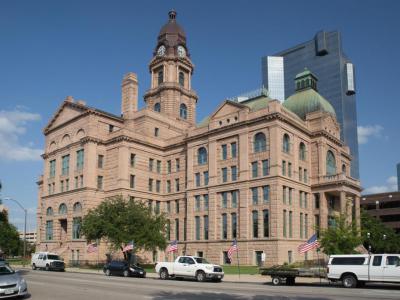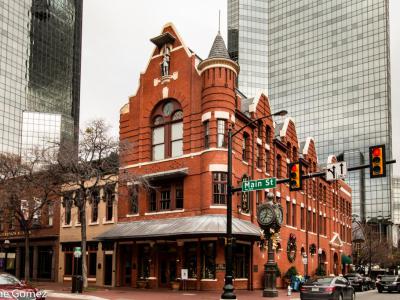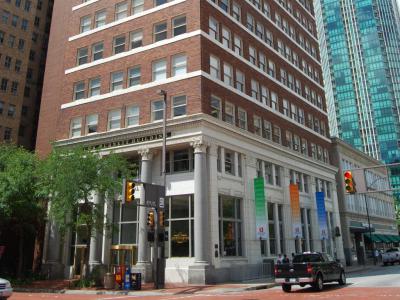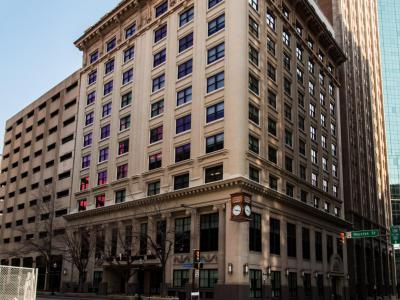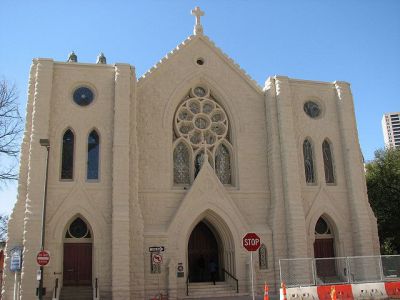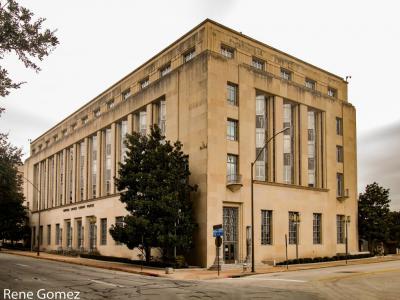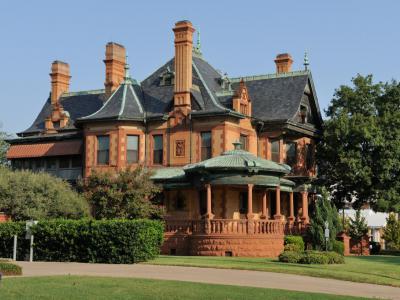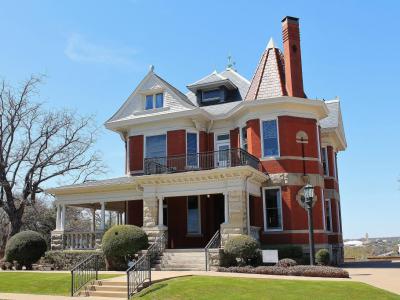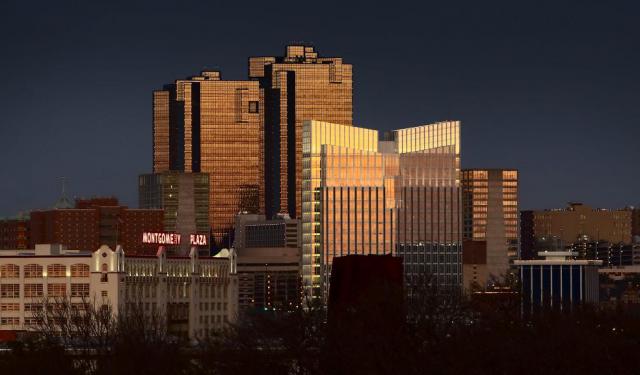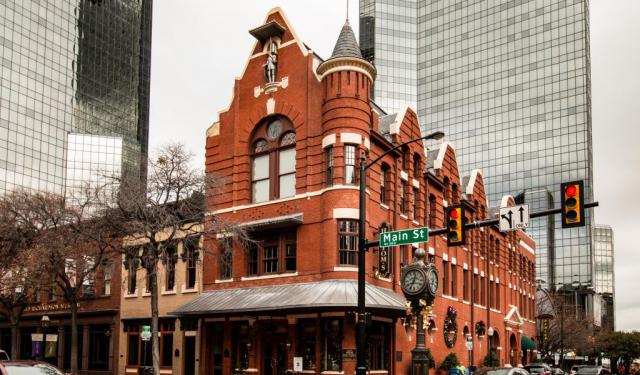
Fort Worth Historical Buildings (Self Guided), Fort Worth
Among the many ways to explore the richness of heritage fabric in Fort Worth there is one by historical architecture. Back in the 1920s-30s, the majority of Fort Worth’s notable buildings were designed by either Sanguinet & Staats or Wyatt Hedrick.
The former, in particular, were responsible for creating, among other structures, the Flatiron – one of the first high-risers in Fort Worth. The design was inspired by the Flatiron Building in Manhattan; the second floor of the Fort Worth namesake is lined with panther head gargoyles, a nod to Fort Worth’s nickname “Panther City."
The Downtown area, known for its unique rustic architecture, is dominated by Art Deco style. The Tarrant County Courthouse, a distinctive local landmark since its completion in 1895, features the American Beaux Arts design, with some decoration elements and granite used on the facade bearing striking resemblance to the Texas State Capitol building in Austin.
Most of the edifices surrounding Sundance Square, like The Knights of Pythias Building, The Burk Burnett Building, and The First Christian Church, have preserved their original, early 20th-century façades to this day. The Burk Burnett Building, in particular, is an excellent example of Neoclassical hi-rise architecture in Fort Worth, prominently standing 12 stories over the plaza.
Given that most of the city's noteworthy structures, these and others, are in close proximity to each other, the best way to observe them is on foot. And if you intend to embark on an architectural journey in Fort Worth by yourself, it is best done with the help of our self-guided tour!
The former, in particular, were responsible for creating, among other structures, the Flatiron – one of the first high-risers in Fort Worth. The design was inspired by the Flatiron Building in Manhattan; the second floor of the Fort Worth namesake is lined with panther head gargoyles, a nod to Fort Worth’s nickname “Panther City."
The Downtown area, known for its unique rustic architecture, is dominated by Art Deco style. The Tarrant County Courthouse, a distinctive local landmark since its completion in 1895, features the American Beaux Arts design, with some decoration elements and granite used on the facade bearing striking resemblance to the Texas State Capitol building in Austin.
Most of the edifices surrounding Sundance Square, like The Knights of Pythias Building, The Burk Burnett Building, and The First Christian Church, have preserved their original, early 20th-century façades to this day. The Burk Burnett Building, in particular, is an excellent example of Neoclassical hi-rise architecture in Fort Worth, prominently standing 12 stories over the plaza.
Given that most of the city's noteworthy structures, these and others, are in close proximity to each other, the best way to observe them is on foot. And if you intend to embark on an architectural journey in Fort Worth by yourself, it is best done with the help of our self-guided tour!
How it works: Download the app "GPSmyCity: Walks in 1K+ Cities" from Apple App Store or Google Play Store to your mobile phone or tablet. The app turns your mobile device into a personal tour guide and its built-in GPS navigation functions guide you from one tour stop to next. The app works offline, so no data plan is needed when traveling abroad.
Fort Worth Historical Buildings Map
Guide Name: Fort Worth Historical Buildings
Guide Location: USA » Fort Worth (See other walking tours in Fort Worth)
Guide Type: Self-guided Walking Tour (Sightseeing)
# of Attractions: 12
Tour Duration: 2 Hour(s)
Travel Distance: 3.5 Km or 2.2 Miles
Author: IreneB
Sight(s) Featured in This Guide:
Guide Location: USA » Fort Worth (See other walking tours in Fort Worth)
Guide Type: Self-guided Walking Tour (Sightseeing)
# of Attractions: 12
Tour Duration: 2 Hour(s)
Travel Distance: 3.5 Km or 2.2 Miles
Author: IreneB
Sight(s) Featured in This Guide:
- Tarrant County Courthouse
- Knights of Pythias Building
- Burk Burnett Building
- First Christian Church
- First National Bank Building
- Bryce Building
- Flatiron Building
- St. Patrick Cathedral
- Eldon B. Mahon United States Courthouse
- First United Methodist Church
- Eddleman–McFarland House
- Pollock–Capps House
1) Tarrant County Courthouse
The Tarrant County Courthouse was designed by the architecture firm of Frederick C. Gunn and Louis Curtiss and built by the Probst Construction Company of Chicago, 1893–1895. It is a pink Texas granite building in Renaissance Revival style, closely resembling the Texas State Capitol with the exception of the clock tower. The cost was $408,840 and citizens considered it such a public extravagance that a new County Commissioners' Court was elected in 1894.
A monument dedicated to Confederate Army soldiers was erected on the grounds by the United Daughters of the Confederacy in 1953. In 1958, a Civil Courts Building was constructed on the west side of the courthouse. In 2012, a $4.5 million renovation to the clock tower was completed. In 2013, the Civil Courts Building was demolished.
The Tarrant County Courthouse currently houses the Tarrant County clerk's office, probate and county courts at law, a law library, and the Tarrant County facilities management department.
A monument dedicated to Confederate Army soldiers was erected on the grounds by the United Daughters of the Confederacy in 1953. In 1958, a Civil Courts Building was constructed on the west side of the courthouse. In 2012, a $4.5 million renovation to the clock tower was completed. In 2013, the Civil Courts Building was demolished.
The Tarrant County Courthouse currently houses the Tarrant County clerk's office, probate and county courts at law, a law library, and the Tarrant County facilities management department.
Sight description based on Wikipedia.
2) Knights of Pythias Building
The Knights of Pythias Building, also referred to as the Knights of Pythias Castle Hall, is a historic building in downtown Forth Worth. Located in Sundance Square, the building is a Recorded Texas Historic Landmark. It also holds a spot on the National Register of Historic Places.
The first Pythian Castle Hall was built on this site in 1881. After it burned, the current redbrick building was erected in 1901. This building was the site of Fort Worth's first coin-operated laundry and the first offset printing press.
The Knights of Pythias is a fraternal organization that was founded in 1864. Though membership has considerably waned, it once had nearly one million members throughout the world. Notable knights have included Louis Armstrong, Nelson Rockefeller and Franklin D. Roosevelt.
Visitors are welcome to explore the Knights of Pythias Building as its lower floor has been converted into a retail space. From the outside, visitors can take note of the Pythian knight that overlooks Main Street.
The first Pythian Castle Hall was built on this site in 1881. After it burned, the current redbrick building was erected in 1901. This building was the site of Fort Worth's first coin-operated laundry and the first offset printing press.
The Knights of Pythias is a fraternal organization that was founded in 1864. Though membership has considerably waned, it once had nearly one million members throughout the world. Notable knights have included Louis Armstrong, Nelson Rockefeller and Franklin D. Roosevelt.
Visitors are welcome to explore the Knights of Pythias Building as its lower floor has been converted into a retail space. From the outside, visitors can take note of the Pythian knight that overlooks Main Street.
3) Burk Burnett Building
The Burk Burnett Building is a building in downtown Fort Worth, Texas, located in Sundance Square. It has twelve floors and is 156 feet (48 m) high. The ground floor of the building is occupied by Worthington National Bank. The Burk Burnett Building has been listed on National Register of Historic Places since November 12, 1980.
The Burk Burnett Building was designed by Sanguinet & Staats and built in 1914. At the time of construction, it was the tallest building of the city and became the first skyscraper in Fort Worth. It was originally occupied by the State National Bank.
The Burk Burnett Building is built in a neoclassical style. The lower part of the building (two floors) is made of white terracotta and of granite columns, the middle part (eight floors) is of red brick with terracotta layers separating floors, and the top part (two floors) is decorated white terracotta.
The Burk Burnett Building was designed by Sanguinet & Staats and built in 1914. At the time of construction, it was the tallest building of the city and became the first skyscraper in Fort Worth. It was originally occupied by the State National Bank.
The Burk Burnett Building is built in a neoclassical style. The lower part of the building (two floors) is made of white terracotta and of granite columns, the middle part (eight floors) is of red brick with terracotta layers separating floors, and the top part (two floors) is decorated white terracotta.
Sight description based on Wikipedia.
4) First Christian Church
The First Christian Church of Fort Worth is a historic church in the Sundance Square district. The church was built in 1915 and designed by architects E.W. Van Slyke and Clyde Woodruff. The architects chose a Beaux Arts and Renaissance Revival style for the design.
The church was founded in 1855. It is the oldest continuously operating church in the city. Originally, the congregation met in the home of a local doctor. It then moved to a masonic building before the rock structure was erected at the site of the current church.
Visitors will find that the limestone building has a Greek Cross plan, meaning it has a square central mass with four arms. It also has a copper dome and Corinthian columns. The building was given the Forth Worth Historical and Cultural Landmarks designation. It is also on the National Register of Historic Places.
Visitors are welcome to attend Sunday worship at 10:50 AM. Inside the church, parishioners will find a wood carving of Da Vinci's "The Last Supper" and an interior view of the stained glass cupola.
The church was founded in 1855. It is the oldest continuously operating church in the city. Originally, the congregation met in the home of a local doctor. It then moved to a masonic building before the rock structure was erected at the site of the current church.
Visitors will find that the limestone building has a Greek Cross plan, meaning it has a square central mass with four arms. It also has a copper dome and Corinthian columns. The building was given the Forth Worth Historical and Cultural Landmarks designation. It is also on the National Register of Historic Places.
Visitors are welcome to attend Sunday worship at 10:50 AM. Inside the church, parishioners will find a wood carving of Da Vinci's "The Last Supper" and an interior view of the stained glass cupola.
5) First National Bank Building
First National Bank Building was built in 1910. It was designed by Sanguinet & Staats with Wyatt C. Hedrick. It has also been known as Baker Building and as Bob R. Simpson Building.
It is an 11-story three-part vertical commercial block skyscraper building. It was designed by Fort Worth-based Sanguinet & Staats and built in 1910 with width of 3 bays upon Houston Street and 7 bays upon Seventh Street. It was expanded to 7 bays wide on Houston in 1926, following designs of Wyatt C. Hedrick.
Its design includes elements of Beaux-Arts style, in its architectural ornamentation.
It is an 11-story three-part vertical commercial block skyscraper building. It was designed by Fort Worth-based Sanguinet & Staats and built in 1910 with width of 3 bays upon Houston Street and 7 bays upon Seventh Street. It was expanded to 7 bays wide on Houston in 1926, following designs of Wyatt C. Hedrick.
Its design includes elements of Beaux-Arts style, in its architectural ornamentation.
Sight description based on Wikipedia.
6) Bryce Building
Bryce Building is located on 909 Throckmorton Street in Fort Worth, Texas. The two-story office building was named after businessman and former mayor William Bryce. The building was designed in the Classical Revival style. It was constructed with brick made by Denton Press Brick Company. In 1982 a fire caused major damage to the building. The building currently houses a law firm.
It was added to the National Register on February 23, 1984.
It was added to the National Register on February 23, 1984.
Sight description based on Wikipedia.
7) Flatiron Building
The Flatiron Building is located in downtown Fort Worth. At the time of its completion in 1907 it was one of the city's first steel frame buildings and the tallest building in north Texas.
The building was designed by Fort Worth's top architectural firm Sanguinet & Staats in the renaissance revival style. It is constructed of reinforced concrete over a steel frame. The facade is divided into a two-story base supporting a five-story body capped by a heavily ornamented cast iron cornice. The east and west facades are further divided into bays by piers which rise to arches in the top level. The building carries further ornamentation in the form of carved panther heads above the second story and brick lozenges.
Interior design included open floor space to facilitate flexible division into offices. Additionally, "The elevator lobby of the Flatiron, with its handsome Classical details, ceramic tile floor, and marble wainscoting, as well as the ornate iron work of the elevator..." serves to illustrate the attention paid to the public areas of the building in order to entice clients.
The original design specified ten stories, but this had to be scaled back to seven due to budget concerns following the Panic of 1907.
The building is listed in the National Register of Historic Places.
The building was designed by Fort Worth's top architectural firm Sanguinet & Staats in the renaissance revival style. It is constructed of reinforced concrete over a steel frame. The facade is divided into a two-story base supporting a five-story body capped by a heavily ornamented cast iron cornice. The east and west facades are further divided into bays by piers which rise to arches in the top level. The building carries further ornamentation in the form of carved panther heads above the second story and brick lozenges.
Interior design included open floor space to facilitate flexible division into offices. Additionally, "The elevator lobby of the Flatiron, with its handsome Classical details, ceramic tile floor, and marble wainscoting, as well as the ornate iron work of the elevator..." serves to illustrate the attention paid to the public areas of the building in order to entice clients.
The original design specified ten stories, but this had to be scaled back to seven due to budget concerns following the Panic of 1907.
The building is listed in the National Register of Historic Places.
Sight description based on Wikipedia.
8) St. Patrick Cathedral
Saint Patrick Cathedral in Forth Worth is a Catholic Church and a Recorded Texas Historic Landmark. As a parish of the Diocese of Fort Worth, Saint Patrick Cathedral is the seat of the bishop. Construction on the building began in 1888 and completed in 1892. It was designed by architect James J. Kane in the Second Empire, Gothic Revival and Prairie architectural styles.
Visitors to Saint Patrick Cathedral will find that it is easy walking distance from Sundance Square. It is located at the corner of 12th and Throckmorton Streets in the heart of downtown Fort Worth. The Saint Patrick Cathedral Pastoral Center is located directly across 12th Street from the cathedral itself.
The church is open for mass on Sundays at 9:30 AM, 11 AM, 12:30 PM and 5 PM. Services at 8 AM are reserved for senior citizens. There is a 2:30 PM mass delivered in Spanish that is open to all. Daily mass takes place at 12:05 on Monday through Friday. Saturday mass is at 8 AM.
Saint Patrick Cathedral was named on the National Register of Historic Places in 1985.
Visitors to Saint Patrick Cathedral will find that it is easy walking distance from Sundance Square. It is located at the corner of 12th and Throckmorton Streets in the heart of downtown Fort Worth. The Saint Patrick Cathedral Pastoral Center is located directly across 12th Street from the cathedral itself.
The church is open for mass on Sundays at 9:30 AM, 11 AM, 12:30 PM and 5 PM. Services at 8 AM are reserved for senior citizens. There is a 2:30 PM mass delivered in Spanish that is open to all. Daily mass takes place at 12:05 on Monday through Friday. Saturday mass is at 8 AM.
Saint Patrick Cathedral was named on the National Register of Historic Places in 1985.
9) Eldon B. Mahon United States Courthouse
The Eldon B. Mahon United States Courthouse is a courthouse located in Fort Worth, Texas. Built in 1933, the building was listed in the National Register of Historic Places in 2001 and was renamed in honor of district court judge Eldon Brooks Mahon in 2003.
Completed in 1934 during the Great Depression, the courthouse symbolized growth and renewed optimism in Fort Worth. Akin to other buildings of the 1930s, its design and construction fit the pattern of the New Deal-era federal building programs enacted to relieve widespread unemployment.
The building's forward-looking design makes a significant contribution to the city's impressive collection of Depression-era architecture. Renowned Philadelphia architect Paul Philippe Cret, in association with prominent local architect Wiley G. Clarkson, designed the building under the direction of the Office of the Supervising Architect of the U.S. Treasury Department. Clarkson, a native Texan, designed many buildings in Fort Worth during the 1920s and 1930s, including the Trinity Episcopal Church, the Woolworth Building, and the Texas Christian University Library.
n 1938, artist Frank Albert Mechau was commissioned under the Public Works Administration's art programs to paint three oil-on-canvas panels in the fourth-floor Court of Appeals. Mechau's paintings were installed in 1940, becoming the only New Deal art commission sponsored in Fort Worth.
The building is an impressive five-story structure, creating the illusion of a solid limestone mass rising to a height of 94 feet. It is designed in the Art Moderne style, incorporating classical elements. A steel and concrete structure faced with limestone veneer, each elevation adheres to classical principles of symmetry and articulation by a regular rhythm of bays with a centralized principal entrance.
Completed in 1934 during the Great Depression, the courthouse symbolized growth and renewed optimism in Fort Worth. Akin to other buildings of the 1930s, its design and construction fit the pattern of the New Deal-era federal building programs enacted to relieve widespread unemployment.
The building's forward-looking design makes a significant contribution to the city's impressive collection of Depression-era architecture. Renowned Philadelphia architect Paul Philippe Cret, in association with prominent local architect Wiley G. Clarkson, designed the building under the direction of the Office of the Supervising Architect of the U.S. Treasury Department. Clarkson, a native Texan, designed many buildings in Fort Worth during the 1920s and 1930s, including the Trinity Episcopal Church, the Woolworth Building, and the Texas Christian University Library.
n 1938, artist Frank Albert Mechau was commissioned under the Public Works Administration's art programs to paint three oil-on-canvas panels in the fourth-floor Court of Appeals. Mechau's paintings were installed in 1940, becoming the only New Deal art commission sponsored in Fort Worth.
The building is an impressive five-story structure, creating the illusion of a solid limestone mass rising to a height of 94 feet. It is designed in the Art Moderne style, incorporating classical elements. A steel and concrete structure faced with limestone veneer, each elevation adheres to classical principles of symmetry and articulation by a regular rhythm of bays with a centralized principal entrance.
Sight description based on Wikipedia.
10) First United Methodist Church
First United Methodist Church is the most exciting and beautiful attraction of Fort Worth, famous for its architectural design. The primary edifice of this holy place was constructed in 1874, and was named the Fourth Street Methodist Church. In 1887 the church moved to its present address, in the middle of downtown Fort Worth, and began to use its present name. The current building was designed by Wiley G. Clarkson in 1930, in Gothic style. It is important to mention that the church has its own library, where you will find a giant collection of theological literature.
11) Eddleman–McFarland House
The Eddleman–McFarland House, sometimes known as the Ball–Eddleman–McFarland House or just the McFarland House, is a historic residence built in 1899 in the Quality Hill section of Fort Worth.
The house on the bluff above the Trinity River was built in 1899 in the area then known as Quality Hill. This neighborhood contained many of the large Victorian homes of the "Cattle Baron Families", few of which are still standing. Howard Messer designed the house for Sarah Ball, who died within five years of the house's construction. William Eddleman, founder of the Western National Bank, then bought the house. His daughter, Carrie McFarland, lived in the house until her death in 1978. Eddleman's bank was founded in 1906 and failed in 1913.
The Junior League of Fort Worth bought the house in 1979 and it was later acquired by Historic Fort Worth, Inc. It is open for tours and available for rentals.
The exterior of the house is constructed of brick, sandstone, and marble in the Victorian and Queen Anne styles. In the interior are mainly mahogany and oak mantles, cornices, coffered ceilings, paneling and parquet floors.
The house on the bluff above the Trinity River was built in 1899 in the area then known as Quality Hill. This neighborhood contained many of the large Victorian homes of the "Cattle Baron Families", few of which are still standing. Howard Messer designed the house for Sarah Ball, who died within five years of the house's construction. William Eddleman, founder of the Western National Bank, then bought the house. His daughter, Carrie McFarland, lived in the house until her death in 1978. Eddleman's bank was founded in 1906 and failed in 1913.
The Junior League of Fort Worth bought the house in 1979 and it was later acquired by Historic Fort Worth, Inc. It is open for tours and available for rentals.
The exterior of the house is constructed of brick, sandstone, and marble in the Victorian and Queen Anne styles. In the interior are mainly mahogany and oak mantles, cornices, coffered ceilings, paneling and parquet floors.
Sight description based on Wikipedia.
12) Pollock–Capps House
Pollock–Capps House is located next door to the Eddleman-McFarland House. The Queen Anne Victorian style home, located atop a bluff overlooking the Trinity River, was possibly designed by Howard Messer, architect of the Eddleman-McFarland House, and was named after Joseph Robert Pollock, a physician who moved to Fort Worth in 1887.
Pollack and his wife Phoebe sold the house to William and Sallie Capps in 1910. William Capps was a distinguished lawyer while his wife Sallie was president of the Fort Worth Kindergarten Association and a Regent at the College of Industrial Arts in Denton. Historic Fort Worth Inc. purchased the house in 1971. Three years later the organization sold the house to Architect Robert W. Chambers.
The house is built of red brick and limestone, and has a slate roof. The house features an octagonal tower on its northeast corner.
Pollack and his wife Phoebe sold the house to William and Sallie Capps in 1910. William Capps was a distinguished lawyer while his wife Sallie was president of the Fort Worth Kindergarten Association and a Regent at the College of Industrial Arts in Denton. Historic Fort Worth Inc. purchased the house in 1971. Three years later the organization sold the house to Architect Robert W. Chambers.
The house is built of red brick and limestone, and has a slate roof. The house features an octagonal tower on its northeast corner.
Sight description based on Wikipedia.
Walking Tours in Fort Worth, Texas
Create Your Own Walk in Fort Worth
Creating your own self-guided walk in Fort Worth is easy and fun. Choose the city attractions that you want to see and a walk route map will be created just for you. You can even set your hotel as the start point of the walk.
Stockyards Cowtown Walking Tour
Once a major livestock center and a home to cowboys, cattlemen and outlaws, Fort Worth, TX has fully lived up to its nickname – “Cowtown.” From the late 1870s through the mid 1980s, the Fort Worth Stockyards made the city famous, drawing cattle from all over the state. Today mainly inactive, the Stockyards – "the last standing stockyards in the United States" – celebrates Fort... view more
Tour Duration: 1 Hour(s)
Travel Distance: 0.8 Km or 0.5 Miles
Tour Duration: 1 Hour(s)
Travel Distance: 0.8 Km or 0.5 Miles
Cultural District Walking Tour
Just minutes away from the hustle and bustle of the downtown's daily commerce, the Fort Worth Cultural District is a true gem deep in the heart of the city. Bordered by a tree lined boulevard paved with bricks and surrounded by manicured grounds, the area is alive with charming shops and restaurants.
But most importantly, the district is a home to the five prominent museums, such as the... view more
Tour Duration: 2 Hour(s)
Travel Distance: 3.5 Km or 2.2 Miles
But most importantly, the district is a home to the five prominent museums, such as the... view more
Tour Duration: 2 Hour(s)
Travel Distance: 3.5 Km or 2.2 Miles
Fort Worth Introduction Walk
At over 900,000 people in the city proper and more than 7 million in the metro area, Fort Worth is one of the largest cities in the country. This now booming metropolis had a surprisingly meager start less than 200 years ago.
The history of Fort Worth began in 1849 with the establishment of a fort to protect the frontier after the Mexican-American War. Fort Worth was just one fortification in a... view more
Tour Duration: 1 Hour(s)
Travel Distance: 1.5 Km or 0.9 Miles
The history of Fort Worth began in 1849 with the establishment of a fort to protect the frontier after the Mexican-American War. Fort Worth was just one fortification in a... view more
Tour Duration: 1 Hour(s)
Travel Distance: 1.5 Km or 0.9 Miles
The Most Popular Cities
/ view all
